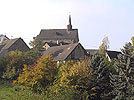Country Germany District Cochem-Zell Elevation 330 m (1,080 ft) Area 6.74 km² Population 536 (31 Dec 2008) Dialling code 02672 | State Rhineland-Palatinate Municipal assoc. Kaisersesch Time zone CET/CEST (UTC+1/+2) Local time Tuesday 11:32 AM Postal code 56754 | |
 | ||
Weather 11°C, Wind W at 16 km/h, 66% Humidity | ||
Roes is an Ortsgemeinde – a municipality belonging to a Verbandsgemeinde, a kind of collective municipality – in the Cochem-Zell district in Rhineland-Palatinate, Germany. It belongs to the Verbandsgemeinde of Kaisersesch.
Contents
- Map of Roes Germany
- Location
- Municipal council
- Mayor
- Coat of arms
- Buildings
- Natural monuments
- Regular events
- References
Map of Roes, Germany
Location
The municipality lies in the part of the eastern Eifel known as the Vordereifel (“Fore-Eifel” or “Further Eifel”), between Treis-Karden and Autobahn A 48.
Municipal council
The council is made up of 12 council members, who were elected by majority vote at the municipal election held on 7 June 2009, and the honorary mayor as chairman.
Mayor
Roes’s mayor is Jörg Fuhrmann, and his deputies are Johannes Schmitt and Michael Sesterhenn.
Coat of arms
The German blazon reads: Über blauem Schildfuß, darin ein silberner Schwan, gespalten durch einen mit einer silbernen Urne mit drei goldenen Ähren und Halmen belegten grünen Pfahl; vorne in Silber ein roter Sparrenschrägbalken; hinten in Silber drei rote heraldische Rosen, pfahlweise übereinander.
The municipality’s arms might in English heraldic language be described thus: Argent, between a bend dancetty and three roses in pale gules a pale vert charged with an urn of the first issuant from which three ears of wheat Or, on a base azure a swan sans legs of the first.
The swan refers to the Schwanenkirche (“Swan’s Church”), which was originally built between about 1460 and 1492. The “bend dancetty” (diagonal zigzag) is drawn from the arms once borne by the Lords of Pyrmont, who built the Schwanenkirche. In 1936, from a cremation grave from Urnfield times east of the Roes-Brohl road came the urn that stands as a charge on the pale. This stands for the long history of settlement in the area. The three ears of wheat stand for agriculture. The three roses are a canting charge, referring to the municipality’s name and its origin.
Buildings
The following are listed buildings or sites in Rhineland-Palatinate’s Directory of Cultural Monuments:
Also, although not a listed building, an old school building is also to be found in Roes.
